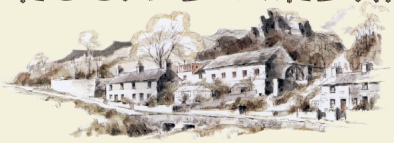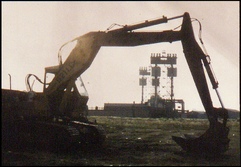FALCON’S COMMENTS ON INDIVIDUAL PHOTOGRAPHS
(please click on each image to enlarge)
The first four photographs on the left are of Halifax, taken in 1959, when streets were paved with granite setts and lit by gas lamps - and for economy boys wore short trousers. All that has now gone and the hope is that the local Yorkshire stone, of which the buildings were made, was not wasted on landfill - and if it was that it can be recovered as the valuable and beautiful building material that it is. Likewise with the granite setts, which represent many thousands of tedious hours squaring up, often as part of the harsh regime of the workhouse. And of course the chimneys very noticeable in the lower two photographs have all long gone.
These next seven photographs were also taken in 1959 and are of Leeds, where terraces of back-to-back house were commonplace, meaning that a dividing wall ran along the entire length of the terrace in line with the roof ridge, with dwellings opening direct onto a street on each side. So there were no backs, which explains why washing had to be hung across the street. Toilets and dustbins were in yards at intervals along the terrace (as seen in the lower photograph). The house that I stayed in, as the guest of a fellow student, wasn’t a back-to-back, so did have a backyard (and back street), and as a special bonus the front room, in this instance, was a fish and chip shop, so I was all right there!
The next two photographs are of Grimsby, the fishing town of my birth. The top photograph is of the Riverhead where part of the docks come right into the town centre. Although still there, it now languishes unused and unloved, but in the time of my childhood it was the wharf of Blows Steamers so was a good place to watch a bit of marine activity, whilst waiting for a trolleybus. It was also a favourite spot for fishermen and adventurous boys, one of whom appears to have caught a crab.
The bottom photograph was also taken in the 1950s, no later than 1954 and shows a cluster of pre-industrial fishing smacks, including “Rock of Ages” and “Adventure”, moored in a quiet corner of the docks away from all the activity. Clearly they appear to be in fairly good condition and still virtually complete, even to the extent of having a beam trawl (barely visible) and a boatman working on something.
A pity this is in black and white as it formed a colourful group of shops still doing good business, in a range of decidedly decrepit old buildings, overlaid with signs and peeling posters, on the Radford Road in Coventry in 1954.
Scrapyard in Cleveland 1977
Consett steelworks, Co Durham,
viewed over allotment 1974
Gatehouse to Wallsend shipyard (Tyneside) 1974. Message across gable reads “Watching these hours soon past, remember that which comes at last”.
Rather inappropriate I thought, as from what I saw of shipyard work, there was little opportunity for idly watching time pass, and what came at the end of the working day must have been a blessed relief from all the deafening noise and intense labour.
A jovial example of the signwriters art painted directly onto the brickwork. This example photographed in 1972, was in Crewe, but I came across similar examples in other towns.
Chapel neatly fitted under railway arch,
Runcorn 1974.
Lift bridge framed by a JCB,
Middlesborough 1974
The old Redheugh Bridge,
Newcastle upon Tyne 1973
The Windsor Lion
at the end of a street
in Wallsend on Tyne 1974
FALCON’S INTRODUCTION TO WHY THESE PHOTOGRAPHS WERE TAKEN
It is little known that plans for the rebuilding of war-damaged Britain began as
early as 1942, less than three years from the start of the war. These were briefly
outlined in a very slim booklet published by HMSO (His Majesties' Stationery Office),
in the knowledge of two fundamentals. Firstly, that regardless of the outcome (victory
or defeat) there would be a vast amount of repair work to do, and secondly, by the
end of the long and desperate struggle, technology, the economy and social expectations
would have changed so much that a completely fresh start would be the most sensible
way to tackle the problem. Wren had proposed much the same after the devastating
fire of London - use the opportunity to build for the future. So instead of mere
repair, the much bolder policy of Comprehensive Redevelopment was decided upon.
My first experience of this came in the late 1940s on seeing a beautiful architectural
model for the new city centre of Coventry, which had been almost completely obliterated
in the notorious blitz of November 1940. Until then, for the first thirteen or so
years of my life, I had only experienced a drab world of bombed sites, camouflage,
blackout, rationing and post war austerity. Shortly after seeing the model, the first
tower cranes appeared and construction began, whilst on the edge of the town a small
development of shops and flats appeared - low three-storey modern buildings of steel
and sparkling glass, with brightly coloured panels rather like a Mondrian painting,
and with spacious centrally heated interiors, bathed in sunlight and looking out
onto open countryside with mature trees.
Then there was the wonderfully uplifting
Festival of Britain of 1951, and shortly after a fellow student started her career
as an art teacher in one of the new comprehensive schools, where the art department
was so lavishly equipped it looked more like something from the other side of the
Atlantic!
It was all a wonderful start and I wanted to be part of it, so went on to train as
a designer.
But then things started to go wrong. The first sign of this to me was when an attractive
piece of Victorian architecture - the market hall tower in Coventry - was pulled
down to make way for the new city centre. It seemed quite wrong that a landmark
structure so symbolic of the city’s former commercial life and art, which had survived
the bombing and which took up so little space anyway, should not have had a rightful
and honourable space in the new city.
Then, as I travelled around the country, I found similar destruction taking place
everywhere - and on a vast scale. We were destroying the good along with the bad.
Comprehensive Redevelopment had become indiscriminate.
In reaction to this, my focus
in the late 1950s, turned more and more from designing to recording. This was when
I started the Worktown project and decided to take the photographs that follow, as
a historical record of places and their architecture, before these also fell the
way of the destruction taking place at the time.














